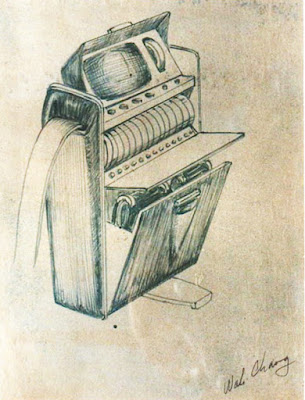Ah, the Tricorder. That amazing machine that instantly told Captain Kirk (and us) just what the heck was going on 300 meters ahead of wherever the heck they were. Unlike most TOS props, the Tricorder was actually a story-telling device, meant to inform the audience of some piece of information that would otherwise not be available. They served the same purpose as "sensors" did on the Enterprise – they gave us the skinny on something.
 |
| Wah Ming Chang's original Tricorder sketch |
In our research we discovered that there were four different types of prop Trics:
 |
| One of two Hero Tricorders built for TOS |
1. Heroes – "Hero" refers to any prop meant to be seen close-up. It is built to look as sophisticated as possible so as to sell the idea of reality. Two of these highly detailed props were created. Built at the beginning of the show for Season 1 and modified in Seasons 2 & 3.
2. Fiberglass – Three copies were made of these simplified versions meant for longer shots and stunt use. Introduced partway through Season 1 with the episode "Arena.
 |
| Fiberglass versions |
3. Leatherettes – A second type of detailed version meant for close-ups and general use and named for the faux leather used on their exteriors. Two copies were made. Not seen until Season 3, these became the new de facto Heroes, perhaps the original Heroes were too beat up by Season 3, or perhaps they were deemed too cumbersome. Whatever the reason, though, these became the Trics usually seen throughout Season 3.
 |
| Leatherettes |
4. Stunt – A crudely made version used for – what else? – stunt use. Only one was known to exist. This type only appeared in early Season 1 episodes like "Miri" where they obviously didn't want to risk damaging the expensive Heroes. Until the Season 1 episode "Arena", the show apparently only had the two hero props to work with so the stunt was built. This filled the need for a heartier version that could sustain abuse until the Fiberglass versions came along for "Arena".
 |
| Stunt |
So there's our overview. Coming up next, I'll be getting in-depth with the Hero Tricorders and spill the beans on everything known so far. They were the first Trics made, of course, and had quite a convoluted history of use. Trek prop fans won't want to miss it!
LLAP
Don
PLEASE NOTE: if readers have additional information we want to hear from you! Anything that adds to the research is appreciated. And, if we have something wrong, by all means, let us know.

I believe the stunt tricorder was used in "Shore Leave" when Sulu was attacked by the Samurai soldier.
ReplyDeleteIt definitely was. The image I show is from that episode. Specifics on that piece will be explored in a later post. Thanks for reading!
Delete